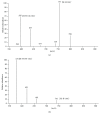Antioxidant and Antisenescence Effects of Bergamot Juice
- PMID: 30116497
- PMCID: PMC6079356
- DOI: 10.1155/2018/9395804
Antioxidant and Antisenescence Effects of Bergamot Juice
Abstract
Aging is one of the main risk factor for the onset of cardiovascular diseases; one of the possible explanations could be linked to the age-associated overproduction of free radicals. This increase of oxidative stress can be overcome with a high intake of food antioxidants. In this context, a number of studies have been addressed to assess the antiaging potential of natural antioxidant compounds. Recently, it has been shown that the juice of bergamot (Citrus bergamia Risso et Poiteau), a fruit mostly produced in the Ionian coastal areas of Southern Italy (Calabria), is a valuable source of health-promoting constituents with, among other, antioxidant properties. In order to investigate the potential antiaging effects of this Mediterranean natural antioxidant source, bergamot juices of three different cultivars ("fantastico," "femminello," and "castagnaro") were herein characterized by the mean of high-performance liquid chromatography-photodiode array-electrospray ionization-tandem mass spectrometry. Then, juices were investigated for the evaluation of total polyphenolic and flavonoid contents, cell-free model antioxidant activities, and in vitro antiaging properties on two different cellular models of induced myocardial senescence. The best performing juice was also assessed in vivo. The phytochemical profiles confirmed that juices were rich in flavonoids, both flavone and flavanone glycosides. In addition, two limonoid glycosides were also identified in all cultivars. Each cultivar showed different phenolic and flavonoid contents. In tube results showed the juice robust antioxidant activities that correlate with their phenolic and flavonoid contents. Moreover, for the first time, the ability of juice to counteract the chemical-induced senescence was here demonstrated in both cellular models. Lastly, the in vivo data obtained from mouse hearts evidenced an increase in transcription of genes involved in antiaging and antioxidant responses. The overall results suggest that bergamot juice exerts antioxidant and antisenescence effects, making it useful for nutraceutical purposes.
Figures







Similar articles
-
Distribution of flavonoids and furocoumarins in juices from cultivars of Citrus bergamia Risso.J Agric Food Chem. 2007 Nov 28;55(24):9921-7. doi: 10.1021/jf072065s. Epub 2007 Oct 26. J Agric Food Chem. 2007. PMID: 17960888
-
Protective Effects of Bergamot (Citrus bergamia Risso & Poiteau) Juice in Rats Fed with High-Fat Diet.Planta Med. 2020 Feb;86(3):180-189. doi: 10.1055/a-1070-9325. Epub 2019 Dec 11. Planta Med. 2020. PMID: 31860116
-
Estimating bergamot juice adulteration of lemon juice by high-performance liquid chromatography (HPLC) analysis of flavanone glycosides.J Agric Food Chem. 2008 Jul 9;56(13):5407-14. doi: 10.1021/jf8006823. Epub 2008 Jun 17. J Agric Food Chem. 2008. PMID: 18557623
-
Vitamin C and the role of citrus juices as functional food.Nat Prod Commun. 2009 May;4(5):677-700. Nat Prod Commun. 2009. PMID: 19445318 Review.
-
Bergamot (Citrus bergamia Risso) Flavonoids and Their Potential Benefits in Human Hyperlipidemia and Atherosclerosis: an Overview.Mini Rev Med Chem. 2016;16(8):619-29. doi: 10.2174/1389557515666150709110222. Mini Rev Med Chem. 2016. PMID: 26156545 Review.
Cited by
-
Hepatoprotective Effect of Citrus aurantium L. Against APAP-induced Liver Injury by Regulating Liver Lipid Metabolism and Apoptosis.Int J Biol Sci. 2020 Jan 14;16(5):752-765. doi: 10.7150/ijbs.40612. eCollection 2020. Int J Biol Sci. 2020. PMID: 32071546 Free PMC article.
-
Analytical Profile and Antioxidant and Anti-Inflammatory Activities of the Enriched Polyphenol Fractions Isolated from Bergamot Fruit and Leave.Antioxidants (Basel). 2021 Jan 20;10(2):141. doi: 10.3390/antiox10020141. Antioxidants (Basel). 2021. PMID: 33498213 Free PMC article.
-
A Herbal Mixture from Propolis, Pomegranate, and Grape Pomace Endowed with Anti-Inflammatory Activity in an In Vivo Rheumatoid Arthritis Model.Molecules. 2020 May 11;25(9):2255. doi: 10.3390/molecules25092255. Molecules. 2020. PMID: 32403241 Free PMC article.
-
Quality Evaluation of Bergamot Juice Produced in Different Areas of Calabria Region.Foods. 2024 Jul 1;13(13):2080. doi: 10.3390/foods13132080. Foods. 2024. PMID: 38998585 Free PMC article.
-
Resveratrol-like Compounds as SIRT1 Activators.Int J Mol Sci. 2022 Dec 1;23(23):15105. doi: 10.3390/ijms232315105. Int J Mol Sci. 2022. PMID: 36499460 Free PMC article.
References
MeSH terms
Substances
LinkOut - more resources
Full Text Sources
Other Literature Sources
Medical

